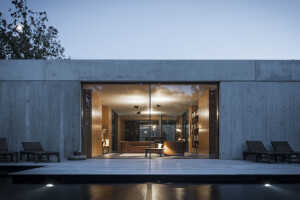The name of the house is AQUA House. With expertise in the area of Sustainability, the office was chosen by Inovatech Engineering, a sustainability consulting at construction area, to develop the project for the first time. Casa AQUA leave the paper and now is a house built and, according to company plans, should go to auction. Casa AQUA is designed according to the Referential Technical Sustainable Building Certification - Aqua Process (High Environmental Quality), launched in April 2008 by Vanzolini, inspired by the French system HQE (Haute Qualité Environnementale) and adapted to Brazilian reality. Sustainable solutions of Casa AQUA: - With 50 m², the house used a Filand construction technology made by Kronan company, which enabled the delivery of the house in only 10 days. This system consists of prefabricated concrete slabs, panels that replace the columns, beams and walls of a building. - System with bolted connections which allow the dismantling of the house, transport and assembly in another location. - To ensure thermal comfort, we opted for ventilated facades and green roof system. The ventilated façade is a solution that creates an air cushion between the structure of the house and the exterior finish, providing thermal, acoustic and energy performance. - It is autonomous in electricity consumption and equipped with photovoltaic panels that will generate energy, which will be used to power the lighting and outlets, and charge an electric vehicle. - The solution is possible due to architectural design, thinking that the house does not have air conditioning and have natural lighting, and efficient electrical equipment and low-power LED lamps. - The automation system installed in the home will monitor in real-time the consume of energy in the house, generated by photovoltaic panes, as well as control devices remotely. The expectation is to reduce the order of 30% in consumption compared to a residence without a monitoring system. - For rainwater utilization was implanted system that follows the concept of modularity and adaptability of the construction for the various user life stages. Are modules of 97 liters, which can be interconnected in the system "plug and play"as non-potable water needs increase or decrease over the years.









































